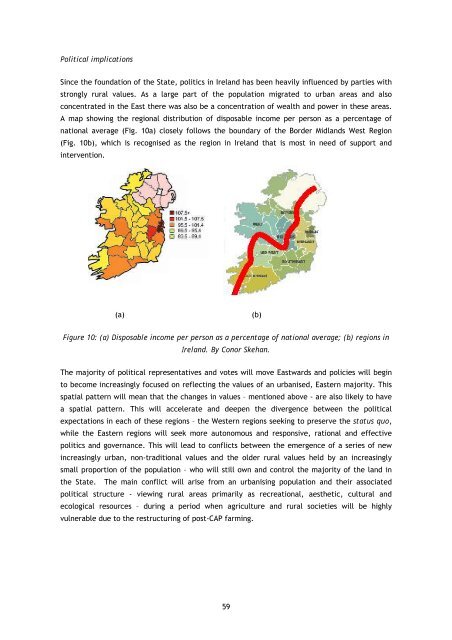TWICE THE SIZE - DIT Update - Dublin Institute of Technology
TWICE THE SIZE - DIT Update - Dublin Institute of Technology
TWICE THE SIZE - DIT Update - Dublin Institute of Technology
You also want an ePaper? Increase the reach of your titles
YUMPU automatically turns print PDFs into web optimized ePapers that Google loves.
Political implications<br />
Since the foundation <strong>of</strong> the State, politics in Ireland has been heavily influenced by parties with<br />
strongly rural values. As a large part <strong>of</strong> the population migrated to urban areas and also<br />
concentrated in the East there was also be a concentration <strong>of</strong> wealth and power in these areas.<br />
A map showing the regional distribution <strong>of</strong> disposable income per person as a percentage <strong>of</strong><br />
national average (Fig. 10a) closely follows the boundary <strong>of</strong> the Border Midlands West Region<br />
(Fig. 10b), which is recognised as the region in Ireland that is most in need <strong>of</strong> support and<br />
intervention.<br />
(a) (b)<br />
Figure 10: (a) Disposable income per person as a percentage <strong>of</strong> national average; (b) regions in<br />
Ireland. By Conor Skehan.<br />
The majority <strong>of</strong> political representatives and votes will move Eastwards and policies will begin<br />
to become increasingly focused on reflecting the values <strong>of</strong> an urbanised, Eastern majority. This<br />
spatial pattern will mean that the changes in values – mentioned above - are also likely to have<br />
a spatial pattern. This will accelerate and deepen the divergence between the political<br />
expectations in each <strong>of</strong> these regions – the Western regions seeking to preserve the status quo,<br />
while the Eastern regions will seek more autonomous and responsive, rational and effective<br />
politics and governance. This will lead to conflicts between the emergence <strong>of</strong> a series <strong>of</strong> new<br />
increasingly urban, non-traditional values and the older rural values held by an increasingly<br />
small proportion <strong>of</strong> the population – who will still own and control the majority <strong>of</strong> the land in<br />
the State. The main conflict will arise from an urbanising population and their associated<br />
political structure - viewing rural areas primarily as recreational, aesthetic, cultural and<br />
ecological resources – during a period when agriculture and rural societies will be highly<br />
vulnerable due to the restructuring <strong>of</strong> post-CAP farming.<br />
59








